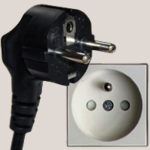Know before you go
France
General Information
France is located in Western Europe bordering Spain, Andorra, Italy, Monaco, Switzerland, Germany, Luxembourg and Belgium. Its capital and largest city is Paris. France is both a member of the European Union and the Schengen Agreement. They drive on the right side of the road.
Visa
Holders of a EU passport don’t require a Visa. For holders of a different passport check out this link to see if you are required to apply for a visa or not or contact your ministery of foreign affairs.
Watch Geography Now!
The video will give you a good first overview of France.

Power
France uses Type E plug outlets. They also work with Type C and F if it has an additional pinhole. The voltage is 230 Volt and the frequency is 50 Hz.
Language
No surprise, the official language of France is French. It’s not always easy to get by with English.
| French | English |
|---|---|
| Salut! | Hello! |
| Salut! | Bye! |
| oui | yes |
| non | no |
| Merci! | Thank you! |
| De rien! | You're welcome! |
| Excusez-moi! | Excuse me! |
| Santé! | Cheers! |
Weather Forecast
Climate
Most of the low-lying areas of metropolitan France are located in the oceanic climate zone. Corsica and a small part of the territory bordering the mediterranean basin lies in the Mediterranean climate zone. In mountainous areas you will find an Alpine Climate. As the French metropolitan territory is relatively large, the climate is not uniform, giving rise to the many different climate nuances.
Average Temperature in Paris
Average Precipitation in Paris
Transportation
How to get there?
The biggest airports in France are Charles de Gaulle Airport (CDG) and Orly Airport (ORY), both located in Paris. Pay attention which airport you need to go to as they are at opposite sides of the city. Both are connected to the RER B train line which in turn connects to the Paris Metro. Follow this link to find out how to get to Orly Airport and this link to find out how to get to Charles de Gaulle Airport.
It is also easy to travel to France by bus or train from any neighboring country. I recommend taking the train as it can go up to 300 km/h and will be way faster than driving. A highspeed train can take you from Brussels to Paris in only 1:34h. Driving the same distance would take you 3 and a half hours. You can even take a train from London which will take you around 2:20h.
How to get around?
Larger cities like Paris have an excellent public transportation network. It will take you everywhere you need to go.
Money, Money, Money

Currency
France is part of the Eurozone and therefore uses the Euro as its currency. Check out the currency converter to find out about current exchange rates.
Accommodation
Depending on where you are staying prices will vary of course. Using airbnb we paid an average of around 35€ per person per night.
Cash
Even though credit cards are widely accepted, you should still withdraw Euros at an ATM. Cash is still king in many places like restaurants, markets and small shops. How much you will need of course depends on your spending habits. Expect to need around 40€ per day for food, transportation, activities and souvenirs.


